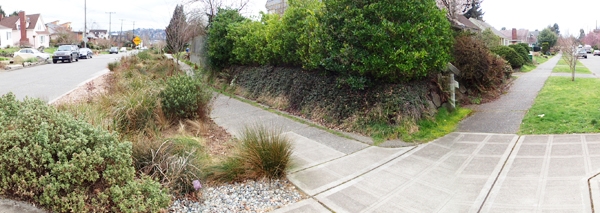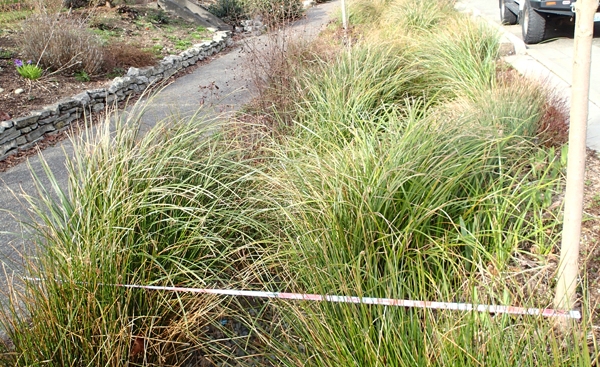
Street-side stormwater facilities are turning runoff once seen as a nuisance into a resource. Also known as bioretention areas, rain gardens, and bioswales, these small stormwater facilities provide a decentralized approach to alleviating peak stormwater runoff and subsequent flood damages. These are particularly critical functions in cities like San Francisco where the storm and sanitary sewer systems are combined because they help managers to prevent dreaded “combined sewer overflow” events. As a bonus, stormwater facilities have also proved useful in promoting groundwater recharge and filtering pollutants as water percolates through soils.
While street-side facilities are effective in helping to manage stormwater runoff, how the trees that are often planted in them fare is not as well-understood. In theory, trees in stormwater facilities serve many purposes, including stabilizing soils and improving water infiltration and uptake of nutrients and pollutants. They also provide the same well-known benefits as other urban trees: shade, carbon sequestration and storage, air pollution reduction, and aesthetic improvement.
The challenge is that trees have been expected to survive and even thrive in stormwater facilities, but there is little research available to guide the process. This is particularly true for climates like California's with distinct wet and dry seasons, where irrigation might be needed to keep trees alive during the summer. This is where Igor Lacan, a University of California cooperative extension advisor, comes in. He has spent much of the last several months outfitting locations in northern California with sensors that will help him to develop best practices for managing trees in street-side stormwater facilities.
Lacan says that tree survival in stormwater facilities likely depends on at least three factors: how long tree roots stay submerged during a storm event, the intensity of California's summer dry period, and the quality of the soil used. He notes that there are likely multiple trade-offs between these factors. He says, for example, that “a permeable sandy soil might drain well during rainy winter months, but would not help trees retain water during the hot, dry summer months. At the same time, a clay soil better at retaining moisture could become waterlogged during a large storm event.”

To better understand these trade-offs, Lacan first has to locate the facilities – a more challenging task he originally imagined. Many easily blend into the surrounding urban landscape, and are incredibly diverse in their design. “No two are alike,” says Lacan. He then identifies the trees, evaluates their size and condition, and installs soil moisture sensors. One of the biggest concerns about the research is how well the sensors – buried in the soils to help escape attention from passersby – will survive periodic immersion in rain water.
Lacan started the project after some casual comments from arborists who expressed reluctance about planting trees in stormwater facilities. He says the concern has now spread to local city foresters as well -- they worry about excessive tree mortality. At this point, he is excited to reassure managers that the “verdict is not yet in” and enlist them as study partners, with the hopes of optimizing tree survival.
After years spent researching stormwater facilities in rainy Portland, Oregon, he says that one interaction while doing field work epitomizes the need for more research on tree survival in California's Mediterranean climate. A man walking by a bioswale as the researcher dug around installing a sensor was asked by his toddler what was going on – the father casually explained that Lacan was fixing the irrigation system. “That one made me smile,” says Lacan. “It is of course natural to think that our California bioswales would come with an irrigation system.”
Post also available in Spanish: Estudian cómo sobreviven los árboles en zonas de retención de agua de lluvia
This research was supported in part through a grant to Principal Investigator Igor Lacan with the University of California, Division of Agriculture and Natural Resources from the California Institute for Water Resources in the University of California's Division of Agriculture and Natural Resources.